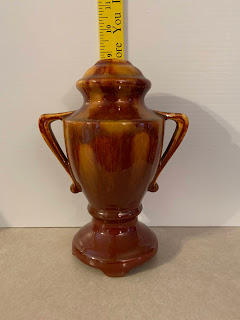Lamps were never on our radar for collecting but over the course of time we have added a few to the collection. We enjoy the challenge of finding them and we are learning to identify them much better. Like all other Medalta pieces the glazes are similar, the clay feels the same and many pieces are not marked. We have not rewired any of them so we don't use any of the lamps.
The
height of this lamp is 5.25". Lamps with the “Owl” decoration are highly prized
by the collectors who own them. Because of its rarity (the 5½" lamp was
produced only in 1932), and marks, it is a prized part of any collection with either
the hand painted Silhouette or Fuzzy Owl decoration.
Lamp
#9 is the earliest of the numbered Medalta lamps, who’s shape started as the hand
made 4 ½" lamp. It was introduced in 1932, and was produced until 1937.
Its height
is 4 1/4" (109 mm), and it is a named lamp, the “Globe” lamp. Most of these do not have an in-mould mark,
and many are unmarked.
Lamp
#11 is the Beehive lamp. This lamp has not been seen with an embossed mark, but
has been seen with the silver Medalta paper sticker, P.2. It also occurs in a
number of classical Medalta glazes, including the multicolor spotted glaze. It
is 5 5/8" (144 mm) high. This
lamp was introduced in 1933 and continued in production until 1937.
Lamp
#43 is 8 1/8" tall. The in-mould marks for these lamps are unusual. Lamp #43 is one of the miniatures, and it is valued because of this. Its mark
is M.17.a. A pink lamp #43 is found in the Eaton’s Catalogues of the thirties,
and these, if found, may well be unmarked.
Lamp
#506 is referred to as the miniature of the post-war series of lamps. It would
be a miniature
of lamp #502. An almost identical lamp
made in the USA has frequently been assumed to be this lamp. The height of the
lamp is 7 7/8. Introduced likely in
1947, this lamp shape was produced briefly in that oxide marked pieces usually
have mark G.38.a, indicating production in the early post-war period.
Lamp
#53 was introduced in 1938. The height of the lamp is 190 mm (7/16"). It has also been seen
with mark G.14.b.
Lamp
#428b the height 10.3 inches. Production
was in 1940 and 1941, and possibly in 1945 and
1946 for the early lamp. This lamp is in
the olive or khaki eggshell finish.
Lamps
#430a in a yellow lacquer finish. The
height of the lamps is 11 ½ inches. for both lamps. The appearance of a painted early lamp
suggests that production of #430a continued
through the war. The early lamp is marked with mark M.18.
Lamp
#24 is 8" tall and could have been included with the large lamps. Lamp
#26, which has a height of 5 3/4" has the same basic shape. The records
list this lamp as being 7 ½" high but this lamp is generally about 8"
in height. This shape was introduced in 1934, and was produced until
1941. This is the longest known production of any Medalta lamp. This lamp is
found with two different impressed mould marks, usually mark M.16, but
occasionally mark M.18.
Lamp
#34 is shown in yellow. The records indicate that, in spite of its small size,
this was an expensive lamp for Medalta. It is the miniature of lamp #31. It was
in production from 1935 to 1940. The lamp measures 6.5" tall. The mark on
this lamp is M.18.
This
is a small hand made lamp, several patterns exist. They are hand painted, and their height is 6
5/8". The lamp has a closed base design.
The marks are G.9 (partial) and G.16.a. This is the Small Square
Shouldered lamp of the Medalta records, produced in 1931 only.
And the Search Continues........



























































